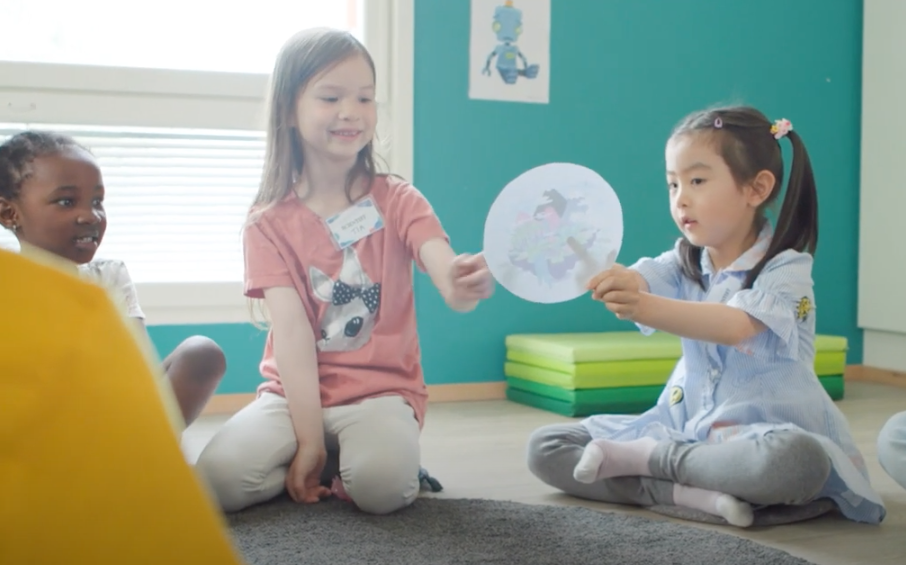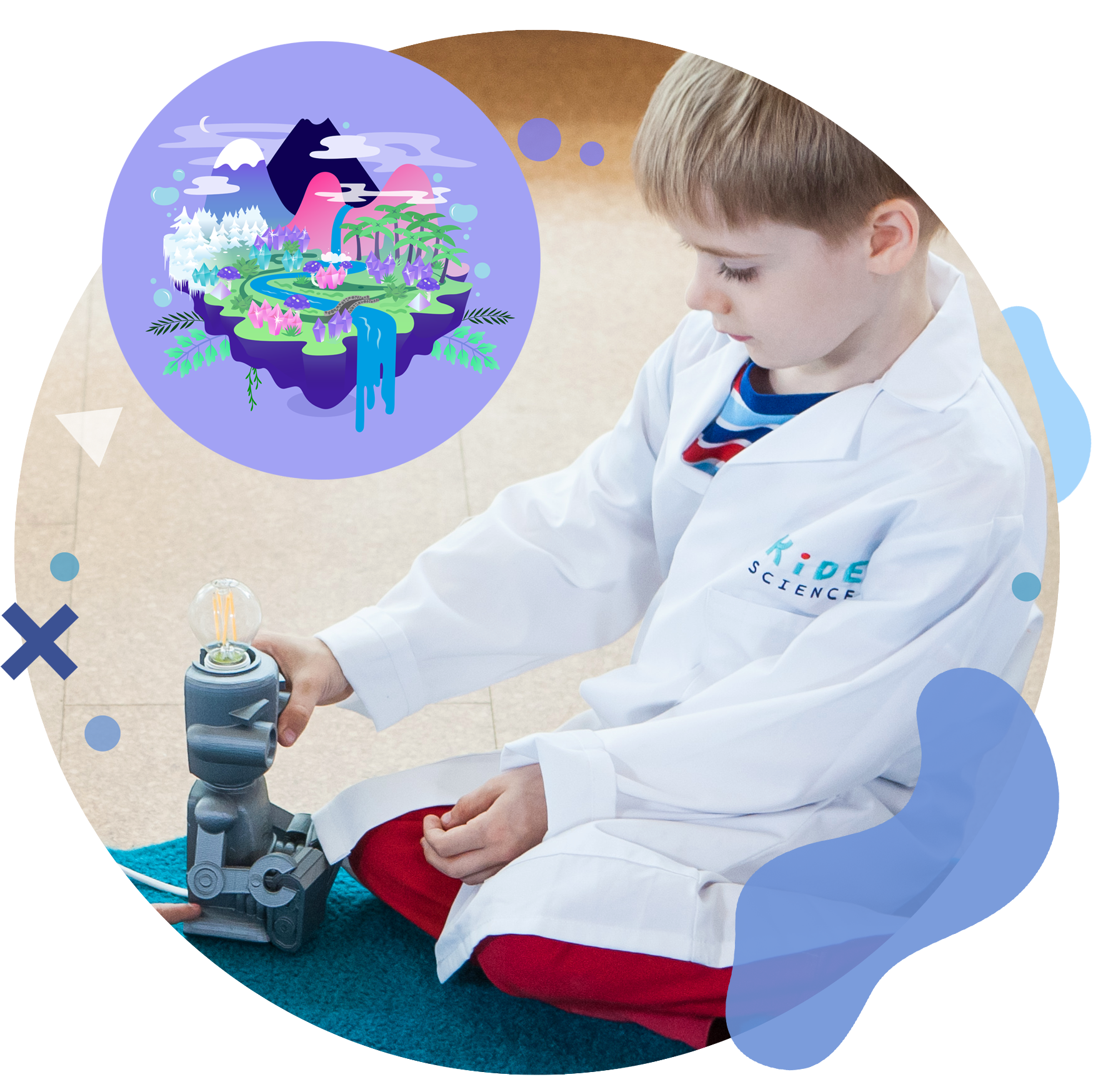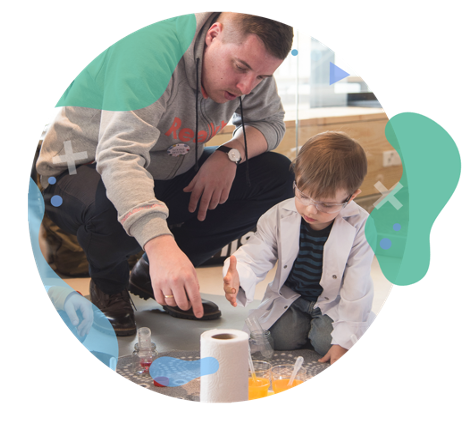Research Behind Kide Science's Playful Inquiry
The pedagogical model that Kide Science utilizes is a result of academic research. Let’s have a look at what theoretical principles underpin Kide Science’s pedagogy.

The pedagogical model that Kide Science utilizes is a result of academic research (Vartiainen, 2016) which is developed further in later studies (Vartiainen & Kumpulainen, 2019a; 2020a, 2020b). Let’s have a look at what theoretical principles underpin Kide Science’s pedagogy.
-
Firstly, we are going to look at science education and what its aims should be, especially amongst young children.
-
Secondly, we illuminate the picture of a young child as a science learner.
-
Finally, we unpack the pedagogical model called Scientific Play that combines dramatic play and scientific inquiry.
#1 Aims for Early Science Education
In the article ‘Promoting Young Children's Scientific Literacy as a Dynamic Practice,’ Vartiainen & Kumpulainen (2019a) presents a new way to comprehend scientific literacy among young children. For a long time, scholars have agreed that scientific literacy is the main aim for science education (eg. ByBee & DeBoer, 1994; Millar, Osborne, & Nott, 1998).
Still, there has been disagreement in what exactly we mean by scientific literacy. Therefore, understanding what we mean by scientific literacy among young children is crucial to realizing what we aim for in early science education.
Science Education for Future Generations
Science is necessary to find out how the world works. It's the basis for creating technologies that solve problems; from everyday issues like remaining dry during a rainstorm, to more complex professional-level problems such as how to cure cancer.
Not all citizens need to solve complex problems such as cancer, energy production, or cutting down industry carbon dioxide emissions. But all citizens can benefit from these skills and knowledge in order to manage their daily science-related problems; whether to choose halogen or LED lights, what detergent to use on blueberry stains, or how to put out a grease fire.
To become a scientifically literate citizen, science education should provide a basic level of knowledge of scientific concepts, in addition to the processes and the nature of science (Norris & Phillips, 2003). They also stress the importance of an individual’s values, wonder, and curiosity. Vartiainen & Kumpulainen (2019a) has further developed the conceptualization of scientific literacy among young children. An important notion is that children should feel belonging in the context of science. Naturally, young children’s science practices are remarkably different from older students’ or adults’ ways to participate in science.
According to Vartiainen and Kumpulainen (2019a) scientific literacy amongst young children can be conceptualized via multiliteracy theory. Therefore, there are three different areas in young children’s scientific literacy, namely:
-
Operational,
-
Cultural, and
-
Critical.
1) Operational Dimension
By operational dimension, Vartiainen & Kumpulainen (2019a) mean skills that are required in the inquiry process. These skills are called science process skills and they are transferable skills which are needed in all fields of science. Young children can practice basic level science process skills which, according to Vartiainen, (2016) are: making observations, measuring, classifying, inferring, predicting, making conclusions, and communicating (Figure 1).
2) Cultural Dimension
Cultural dimension means that science is seen as a cultural practice: with its characteristic symbol systems, ways to communicate and production of knowledge. To adopt cultural practices of science, children need to have versatile possibilities to participate in scientific discussions, inquiries, and processes at their own level (Vartiainen & Kumpulainen, 2019a).
Vartiainen and Kumpulainen (2020b) show that children are able to connect their earlier experiences, share memories of a concept and merge their imagination into scientific inquiry; all when a playful learning environment is present. That means children connect their own cultural practices into the culture of science and hence reproduce the culture by active participation.
An inquiry that is nested in storytelling helps children culturally engage in science and merge their own cultural practices in science (Vartiainen & Kumpulainen, 2020b). Further, Vartiainen and Kumpulainen (2020b) point out that children’s shared imaginative activities and play within science inquiry foster children’s meaning-making about the scientific phenomenon: thus triggering the concept formation.
3) Critical Dimension
Scientifically literate people should be able to critically evaluate the knowledge they meet in everyday life.
In addition, they should be able to recognize texts that are scientifically grounded from opinions, mis- and disinformation. Instant messaging and social media brings even more emphasis on critical thinking skills. Vartiainen and Kumpulainen (2019a) found out that even 3 - 6 -year olds can engage in the critical dimension of scientific literacy. During the inquiry, children questioned processes of inquiry, they evaluated results - as well as conclusions - and they suggested alternative ways to conduct experiments.
Towards Young Children’s Scientific Literacy
Scientific literacy is the main aim for science education and scientific literacy skills start evolving from early childhood. Vartiainen and Kumpulainen (2020b) suggest that scientific literacy should be regarded as a set of skills to produce, share, transform and evaluate the knowledge in emergent contexts.
Rather than concentrating on predetermined science content, it should be seen as a rich set of ways to participate in science culture and practices; seeing scientific literacy gradually developing cognitive ability.
Child-centric approaches which take into consideration children’s culture, interests and living worlds offer children the possibility to actively participate in the cultural process of science and gives them a high-level of agency (Vartiainen & Kumpulainen, 2019a).
Pedagogical approaches which embrace a child as a capable meaning-maker and knowledge constructor can support children’s sense of independence, which is an important competence in scientific literacy (Norris & Phillips, 2003).
Vartiainen and Kumpulainen (2019a) point out that if we amplify children’s agency in science education we can form a learning community where the power of knowledge is not laying solely on teachers, instead the children have true possibilities to produce new ideas. This requires new pedagogical approaches to early science education, and in order to understand these approaches we need to take into account young children as learners.
#2 The Young Child as a Science Learner
It’s widely agreed amongst scholars that children are endlessly curious about their surroundings, and that they ask questions, experiment and explore to build understanding about the world (eg. Eshack & Fried, 2005).
Pedagogical approaches in which children are seen as tabula rasas waiting for someone to fill them up are in harsh contradiction with a child’s natural way to learn. Children have previous experiences, opinions, ideas, and interests that they have already learned from (Dewey, 1986). Many pedagogical approaches in science education fail to meet children’s worlds and their everyday wonders (Krapp and Prenzel, 2011; Osborne, Simon and Collins, 2003; Potvin and Hasni, 2014).
Particularly in early science education, there are often difficulties to embed science education into pedagogical practices which take into consideration young children’s natural ways to learn. Pedagogical models are often copied from school and they are not appropriate for young children.
Play Is a Vital Element for Children’s Development and Learning
For young children, the leading activity is play (Vygotsky, 1967). Leont’ev (1981, p. 396) defines ‘leading activity’ as an activity that is “in connection with whose development the most important changes take place in the child’s psyche and within which psychic processes develop that pave the way for the child’s transition to a new, higher level of development.”
For Vygotsky (1978) play creates a zone of proximal development where a child can reach higher with the help of other people or cultural tools. Vygotsky describes that in the zone of proximal development created through play a child can act “as though he were a head taller than himself” (Vygotsky 1987, p.102).
Since play is a vital element for children’s development and learning, accordingly the vast amount of research underpins that young children’s science education should be play-based (eg. Bulunuz 2013; Andrée & Lager-Nyqvist 2013; Fleer 2013; Akman & Özgül 2015; Caiman and Lundegård 2018; Fleer 2019.) Conceptualization of play in the context of learning often includes aspects of joy, enjoyment, and creativity (eg. Caiman and Lundegård 2018).
However, Vartiainen & Kumpulainen (2020a) points out that still play is defined very differently in the studies. While some studies see that playful science education is something that can happen by involving toys in a learning activity, (Dinçer et al. 2011 cited in Bulunuz, 2013) some studies emphasize the role of imagination and collective scientific narratives (Fleer, 2019).
Play Requires Imagination
Kide Science’s conception of play-based learning is nested in Vygotsky’s (1967) notion of play. Central in play is the creation of imaginary situations. The need for play emerges from children’s unsatisfied desires.
For example, children might want to be firefighters but because the will is not possible to fulfill in real life, they use imagination to experience being firefighters. When children take these imaginative roles they start acting as they think; for example as firefighters do (Andrée & Lager-Nyqvist, 2013).
Kide Science takes advantage of this notion: Teachers and children trigger a shared imaginary situation in which children take the role of scientist and start implementing appropriate ways of acting for the nature of science. According to Vartiainen & Kumpulainen (2019b) imagination and play allow children to translate science into their culture and thus construct meanings of scientific concepts.
#3 Science Inquiry as Scientific Play
An inquiry-based approach is an extensively recommended way to facilitate science education in all levels of learning: from kindergarten to higher education (Minner et al. 2010).
The inquiry-based approach is a philosophy of learning which highlights learning about science and science as a process. It’s a social activity rather than an individual's cognitive activity.
By inquiry approach, we aim to investigate how we know something and why we believe in it (Abd-El-Khalick et al. 2004). Vartiainen & Kumpulainen (2020a) state that scientific inquiry does not merely mean practicing science process skills.
It also combines them with scientific knowledge, reasoning, problem-solving, and critical thinking in a highly social and transformative learning environment. Eventually, the inquiry approach seeks to increase the learner’s independence in decisions such as setting research questions and designing data collection.
It is vital to remember that the younger the learner, more help and modeling from the teacher is needed. Young children’s inquiry process requires careful scaffolding and often so-called guided inquiry is regarded as suitable (Vartiainen, 2016).
Young children’s scientific inquiry benefits from the play-based approach as the play can scaffold children’s inquiry process in each stage. Vartiainen & Kumpulainen (2020a) have created a play-based science inquiry for young children that they call Scientific Play.
Kide Science utilizes the Scientific Play approach to early science education. Scientific Play divides young children’s science inquiry into three stages:
-
Orientation
-
Investigation, and
-
Conclusion
1. Orientation phase
In the orientation phase children, alongside a teacher, step into an imaginary situation. The transition is amplified with stories or poems and props. Props can be laboratory coats and safety goggles, or anything children relate to their role as a scientist.
In addition, a playful character which communicates with children can accelerate the transition; a finger puppet, for example. Kide Science utilizes Hoseli the robot as a playful pivot that invites children to the imaginary situation. A story or a poem read out loud in the orientation phase helps children to set the aim for inquiry. The story introduces a problem that children need to solve.
In the orientation phase, children are introduced to concepts, equipment, and tools that are pivotal for completing the aim.
2. Investigation phase
In the investigation phase, children and teachers create a plan for experimentation and conduct experiments to understand the phenomenon; collecting the data and observations as they go along.
The investigation phase can build up from multiple experiments. The first experiment helps children to get familiar with the concepts at hand by doing observations. These are usually structured activities. The latter experiments usually have more freedom to use creativity and imagination and thus are less structured. In the investigation phase, children do co-operations and co-create meanings.
The narrative of the story is used to keep children engaged and to scaffold children’s meaning-making process.
3. Conclusion phase
The conclusion phase invites children to put together their findings: observations, measurements, and inferences. For young children, drawing conclusions is a highly demanding task. By referring to a story and imaginary play situations, teachers can help children to advise a character in a story; thus scaffolding the conclusion making. The conclusion phase includes finalizing the Scientific Play: teachers and children step out of the roles and take off the props.
As a consequence of implementing the Scientific Play model with children, Vartiainen & Kumpulainen (2020) found that children acted as active producers and users of knowledge throughout the inquiry process.
Their science process skills were comprehensively present and critical thinking was activated. In addition, children’s positive emotions were activated which had remarkable effects on meaning-making and eventually on learning. It was found that the Scientific Play approach appreciated children’s own cultures, languages, and ways of being and thus supported diverse children’s possibilities to engage in science inquiry in meaningful and culturally sensitive ways.
The Essence of Kide Science Pedagogy
To summarize the effect of research on Kide Science pedagogy we can conclude the following.
Kide Science holds that the main aim of science education is to build scientific literacy. Therefore, children learn the operational dimension of scientific literacy; namely science process skills.
The second aim is to get children to participate in the cultural process of science. They are to experience co-creating meanings and become familiar with the language of science: through social interaction.
The third main aim is to engage children in critical thinking: inviting children to question, suggest new ways to produce knowledge, ponder and analyze results by mirroring them in different contexts: either real or products of imagination.
Kide Science pedagogy appreciates children’s natural need to learn by playing. The inquiry-based science education model Kide Science combines science inquiry with stories, imagination, and play. As unfolded in previous chapters, play helps children to translate science into their culture and thus find meaningfulness in science. Acting in the playful role of a scientist helps children to develop their scientific thinking skills but also it fosters children’s positive self-image as a capable science learner and knowledge builder.
Kide Science appreciates children as whole capable persons with their interests and experiences and thus Kide Science allows a high level of agency for children. A playful environment fades the traditional power structures between teacher and children and invites all participants to learn together by co-creating meanings; all in an environment within which imagination reaches beyond what we already know.
You can find a complete collection of the research behind Kide Science by clicking here.
References
Abd-El-Khalick, F., S. Boujaoude, R. Duschl, N. G. Lederman, R. Mamlok-Naaman, A. Hofstein,
and H. L. Tuan. 2004. “Inquiry in Science Education: International Perspectives.” Science
Education 88 (3): 397–419.
Akman, B., and S. G. Özgül. 2015. “Role of Play in Teaching Science in the Early Childhood Years.”
In Research in Early Childhood Science Education, edited by K. Cabe Trundle and M. Saçkes,
237–258. Dordrecht: Springer.
Andrée, M., and L. Lager-Nyqvist. 2013. “Spontaneous Play and Imagination in Everyday Science
Classroom Practice.” Research in Science Education 43 (5): 1735–1750.
Blake, E., & Howitt, C. (2012). Science in early learning centres: Satisfying curiosity, guided
play or lost opportunities? In K.C.D. Tan & M Kim (eds.). Issues and challenges in
science education research: Moving forward, (pp. 281-299). Springer: The Netherlands.
Bulunuz, M. 2013. “Teaching Science Through Play in Kindergarten: Does Integrated Play and
Science Instruction Build Understanding?” European Early Childhood Education Research
Journal 21 (2): 226–249.
Bybee, R. W., & DeBoer, G. (1994). Research on the goals for science education. Handbook of
research on teaching and learning of science, 357-387.
Caiman, C., and I. Lundegård. 2018. “Young Children’s Imagination in Science Education and
Education for Sustainability.” Cultural Studies of Science Education 13 (3): 687–705.
Eshach, H., and M. N. Fried. 2005. “Should Science be Taught in Early Childhood?” Journal of
Science Education and Technology 14 (3): 315–336.
Dewey, J. (1986). Experience and education. In The educational forum. 50 (3) pp. 241-252. Taylor & Francis Group.
Fleer, M. 2019. “Scientific Playworlds: A Model of Teaching Science in Play-Based Settings.”
Research in Science Education 49 (5): 1257–1278.
Leont’ev, A. N. (1981). Problems in the development of the mind. Moscow, Russia: Progress.
Millar, R., Osborne, J., & Nott, M. (1998). Science education for the future. School Science Review,
80(291), 19–24.
Norris, S. P., & Phillips, L. M. (2003). How literacy in its fundamental sense is central to scientific
literacy. Science Education, 87(2), 224–240.
Vartiainen, J., & Kumpulainen, K. (2020a). Playing with science: manifestation of scientific play in early science inquiry. European Early Childhood Education Research Journal, 28(4), 490-503.
Vartiainen, J., & Kumpulainen, K. (2020b). Makerspaces, Multiliteracies and Early Science Education: The Finnish Approach. In A. Blum-Ross, K. Kumpulainen, & J. Marsh (Eds.), Enhancing Digital Literacy and Creativity: Makerspaces in the Early Years: Makerspaces in the Early Years (pp. 38-52). Abingdon, Oxon: Routledge.
Vartiainen, J., & Kumpulainen, K. (2019). Promoting young children’s scientific literacy as a dynamic practice. In K. Kumpulainen, & J. Sefton-Green (Eds.), Multiliteracies and Early Years Innovation: Perspectives from Finland and Beyond (pp. 77-94). (Routledge Research in Early Childhood Education). London: Routledge.
Vygotsky, L. S. (1967). Play and its role in the mental development of the child. Soviet Psychology, 5, 6-18.
Vygotsky, L. S. (1978). Mind in society: The development of higher psychological processes. Cambridge, MA: Harvard University Press.
.png)

